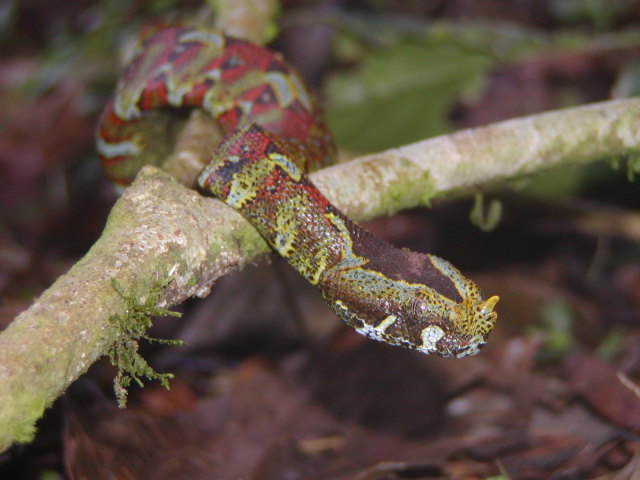
The head is usually a darker shade than the body, and the eyes are golden yellow. The body is covered in a pattern of dark brown and black scales, with a distinctive pattern of white or yellowish spots on the back. It is a large, stocky species with a broad, triangular head and a thick body. They move sideways across the sand, similar to the American Sidewinder, and are often called the Desert Sidewinding Viper.The Rhinoceros Viper is a species of venomous snake found in the tropical rainforests of Central and West Africa. Saharan Vipers are native to the arid regions of North Africa and the Middle East. At 24 inches, they are among the smallest African vipers, however, a bite from this genus of a snake will cause swelling, necrosis, and hemorrhaging. The horns are scales that appear intimidating, but these snakes are not aggressive and prefer to burrow in the desert sand to ambush their prey. The Saharan or Desert Horned Viper is a fascinating species of viper as they possess two moveable horns that protrude just above the eyes. Saharan Horned Viper (Cerastes cerastes) Desert Horned Vipers are unique in appearance

The Rhino Viper is highly poisonous, and the venom is anticoagulant, affecting the blood. Despite the stocky size of this snake, they can climb up trees and strike quickly. Rhinoceros Vipers are considered the most beautiful of all vipers, with a pattern of blue, yellow, and red markings from head to tail.

Known as the Horned Puff Adder, River Jack Snake, and Butterfly Snake, they are found in West and Central Africa. The Rhinoceros Viper owes its name to the 2-4 horn-like scales located on the top of its snout, reminiscent of the Rhinoceros. Rhinoceros Viper (Bitis nasicornis) The horns on the snout of the Rhino viper are upright scales These snakes are ambush predators and use their prehensile tails to hang from a tree, waiting to strike their prey. Puff Adders frequently come into contact with humans and account for the most snake bite fatalities in Africa.įound in the forests of Central Africa, Bush Vipers are described as arboreal and are the only vipers to live in trees. What makes these adders so unique is their strike rate of a tenth of a second, which is the fastest of any snake on the planet! This genus will strike forward and sideways but cannot strike backward.Īdults reach a size of 4 ft and use their camouflage and scent masking to avoid detection by predators. Bitis Arietans is found across Africa, Morocco, and Western Arabia and is feared for its cytotoxic venom that attacks the tissues and blood. Puff Adders owe their name to their ability to puff up their bodies and hiss when they feel threatened. Puff Adder (Bitis arietans) The Puff Adder is a deadly African viper

The West African Viper is responsible for many fatal snake bites every year and frequently hides near human settlements to ambush their prey. These snakes reach a length of 12 to 35 inches, are highly venomous, and are among the fastest-striking vipers in the world.Ĭytotoxic venom produced by Carpet Vipers causes blistering, pain, and tissue damage. Carpet Vipers live in the dry regions of North Africa, India, Sri Lanka, and the Middle East. These include the Egyptian Saw-Scaled Viper and the African Saw-Scaled Viper. The West African Carpet Viper belongs to the Echis genus of snakes, of which there are 12 species. West African Carpet Viper (Echis ocellatus) The West African Carpet Viper is ready to strike However, some Gaboon Vipers inject up to 1000 mg of venom in a single bite. Gaboon Vipers are considered the deadliest vipers in Africa, as only 100 mg of this snake’s venom is lethal to humans. This Forest Puff Adder has a cytotoxic and hemotoxic venom that attacks the body’s circulatory system, eventually causing respiratory paralysis.

Their fangs are so long, they can bite through their bottom jaw to evade a threat. A Gaboon Adder possesses the longest curved fangs and venom sacs of any snake in the world. What makes these snakes so impressive is the size of their fangs, at 2 inches long. They are known as Gaboon Adders, Butterfly Adders, and Forest Puff Adders. The notorious Gaboon Viper is the largest viper in Africa, reaching a length of 6 ft. Gaboon Viper (Bitis gabonica) The Gaboon Viper perfectly blends in with the forest floor


 0 kommentar(er)
0 kommentar(er)
